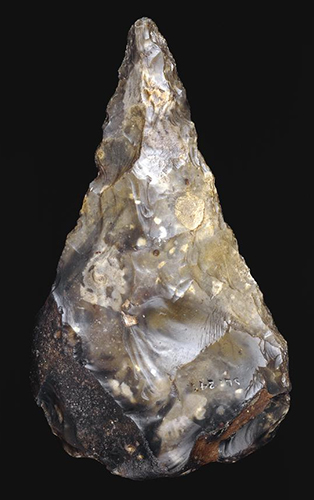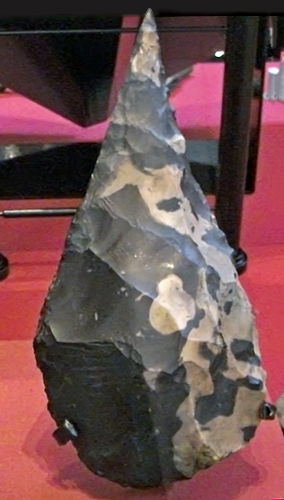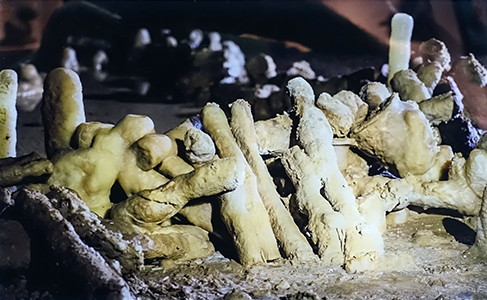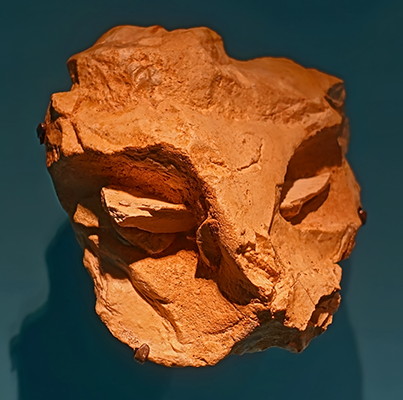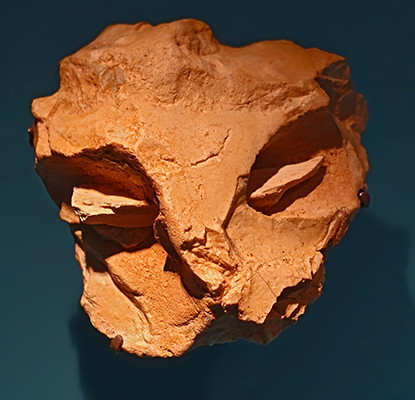Back to Don's Maps
 Back to Archaeological Sites
Back to Archaeological Sites
 Back to the review of hominins
Back to the review of hominins
The development of art in humans

Lines purposefully made on the tibia of an elephant by Homo erectus.
This bone fragment has two groups of 7 and 14 incised parallel lines and might represent an early example of art. The regular spacing of the incisions, their subequal lengths and V-like cross-sections suggest they were created at the same time, with a single stone tool. The interpretation as an early calendar is a possibility.
Photo: Don Hitchcock 2018
Source and text: Original, Halle Landesmuseum für Vorgeschichte, CC-BY-NC-SA @ State Museum of Prehistory Halle
Additional text: Wikipedia

Deliberate scratching on a fossil Pseudodon, almost certainly an engraving made by Homo erectus at Trinil in Indonesia. At around 500 000 BP, the shells represent the earliest evidence of such decorative marks.
Photo: Wim Lustenhouwer, VU University Amsterdam
Source: https://www.smithsonianmag.com/science-nature/oldest-engraving-shell-tools-zigzags-art-java-indonesia-humans-180953522/
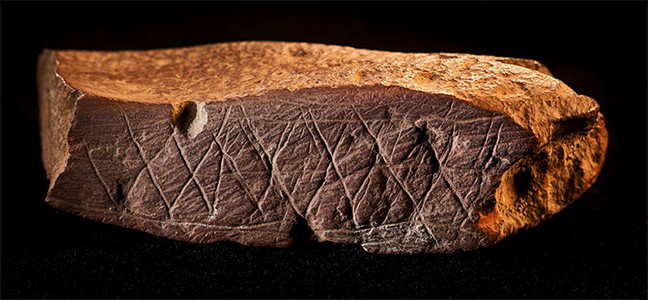
Engraved ochre from Blombos Cave, South Africa, older than 70 000 BP
Photo: © Stephen Alvarez, Alvarez Photography
Source: http://print.alvarezphotography.com/
By BBC News Online science editor Dr David Whitehouse
One of the world’s oldest examples of abstract art, dating back more than 70 000 years, has been found in a cave in South Africa.
Scientists say the discovery shows that modern ways of thinking developed far earlier than we think.The abstract art was found on two pieces of ochre in a cave on the southern Cape shore of the Indian Ocean. Previously, the earliest evidence of abstract art came mainly in France from the Eurasian Palaeolithic period less than 35 000 years ago.
Dr Christopher Henshilwood, from the State University of New York at Stony Brook, says: 'They may have been constructed with symbolic intent, the meaning of which is now unknown.
Dr Christopher Henshilwood believes the items are significant: 'The engraving itself is quite a complex geometric pattern. There is a system to the patterns. We don’t know what they mean, but they are symbols that I think could have been interpreted by those people as having meaning that would have been understood by others.' The engraved ochre pieces were recovered from Middle Stone Age layers at Blombos Cave, 290 kilometres (180 miles) east of Cape Town, and are at least 70 000 years old.Dr Henshilwood says more than 8 000 other pieces of ochre were found in the cave, many of which had been rubbed smooth as if to make pigment powder.
Ochre, a form of iron ore, is frequently found in Stone Age deposits less than 100 000 years old. It may have been used as a body or decorative paint.
The researchers believe that the ochre was first scraped and ground to create flat surfaces. It was then marked with cross hatches and lines to create a complex motif. The find pushes back by some 35 000 years the earliest time when biologically modern humans were known to have developed modern behaviour. 'The theory up until now has been that modern human behaviour started only around 40 000 years ago,' says Dr Henshilwood.'The whole of South Africa was occupied by a biologically modern people who had evolved about 150,000 years ago.'
The research team excavate in Blombos Cave 'There is no doubt that the people in southern Africa were behaviourally modern 70 000 years ago.' Scientists believe that these finds demonstrate that ochre use in the Middle Stone Age was not exclusively utilitarian and, arguably, the transmission and sharing of the meaning of the engravings relied on fully syntactical language. While the markings are suggestive, not all scientists are prepared to classify them as a form of artistic expression and abstract thought. Steve Kuhn of the University of Arizona says the finding is the result of some 'very good work by some very serious researchers'. But he adds: 'I’d be more comfortable if there were more of these engraved stones; if these alleged symbols were found many times in different places. It is possible they were just doodlings that really didn’t mean anything.'
Blombos Cave is 290 kilometres (180 miles) east of Cape Town.
The research was funded by the US National Science Foundation and is published in the journal Science.
Text above: http://originalrockart.wordpress.com/news/
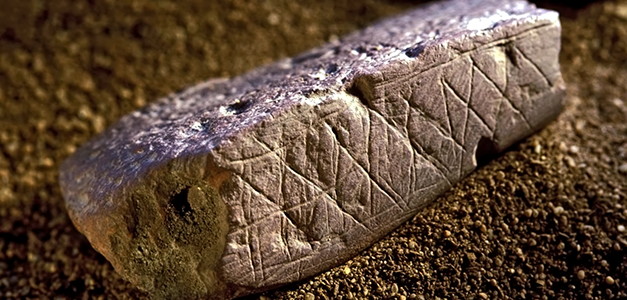
Engraved ochre from Blombos Cave, South Africa. This is of the inverted artefact, showing the 'underneath' side.
Photo: © Chris Henshilwood
Source: https://www.welt.de/wissenschaft/article133442959/Das-Geheimnis-der-weissen-Haende.html
Hand axes as an art form

Acheulean Hand Axe
Narrow Lanceolate Profile.
1.4 - 1.2 million years old
Found in Olduvai Gorge, Tanzania.
Handaxe made of a hard green volcanic lava (phonolite) with a compact texture. Elongated tear drop form with slight ancient damage at tip. Regular edge all round, both faces slightly convex.
( For this handaxe, a case could be made that it is simply a utilitarian tool, with little evidence of beauty or artistic merit - Don )
Catalog: 1934, 1214.49
Photo: Don Hitchcock 2017
Text: Card, http://www.britishmuseum.org/, © Trustees of the British Museum
Source: Exhibition by the British Museum at the National Museum of Australia, Canberra
Acheulean Hand Axes
( For these handaxes, however, I would class them as having evidence of being made as things of beauty, for their own sake, and possibly never actually used. A great deal of effort was put into making these handaxes, far more than I feel was strictly necessary to make a functional tool. I class them as as artistic objects as much as undoubtedly utilitarian ones, much as we might say for a superbly made item of modern furniture, as below. They may well have been status objects, like many superb 'Kimberley Points' made by First Nations artists in Australia in relatively modern times - Don )
Lanceolate Profiles:
Left:
The Gray's Inn Lane Hand Axe is a pointed flint hand axe, found buried in gravel under Gray's Inn Lane, London, England, by pioneering archaeologist John Conyers in 1679. The hand axe is a fine example from about 350 000 years ago, from the Lower Palaeolithic, and probably made by Homo erectus, who made most of these sorts of hand axe.
Photo: © Trustees of the British Museum, CC BY-NC-SA 4.0
Source: https://www.britishmuseum.org/collection/image/10134001, © Trustees of the British Museum, CC BY-NC-SA 4.0
Right:
Another Acheulean hand axe was discovered by John Frere in the 1700s, when he investigated a four metre deep pit (dug by brickworkers) at Hoxne, in England.
Photo: Johnbod
Permission: Creative Commons Attribution-Share Alike 3.0 Unported license.
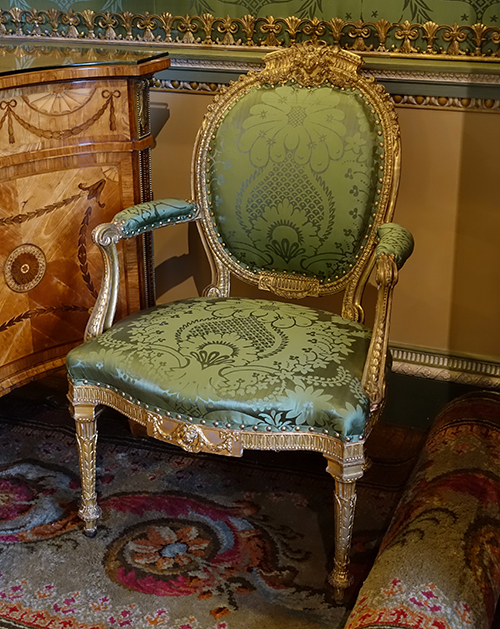
Armchair by Thomas Chippendale, 1773, giltwood , State Bedroom - Harewood House - West Yorkshire, England
( This object is both utilitarian, and a work of art, to my mind in much the same way as a well made Acheulean handaxe - Don )
Photo: Daderot
Permission: This work is in the public domain in its country of origin and other countries and areas where the copyright term is the author's life plus 100 years or fewer.
The photographic reproduction of this work is covered under United Kingdom law (Section 62 of the Copyright, Designs and Patents Act 1988), which states that it is not an infringement to take photographs of buildings, or of sculptures, models for buildings, or works of artistic craftsmanship permanently located in a public place or in premises open to the public. This does not apply to two-dimensional graphic works such as posters or murals. See COM:CRT/United Kingdom#Freedom of panorama for more information.
Proximal Source: Wikipedia
Neanderthal Stone Circles
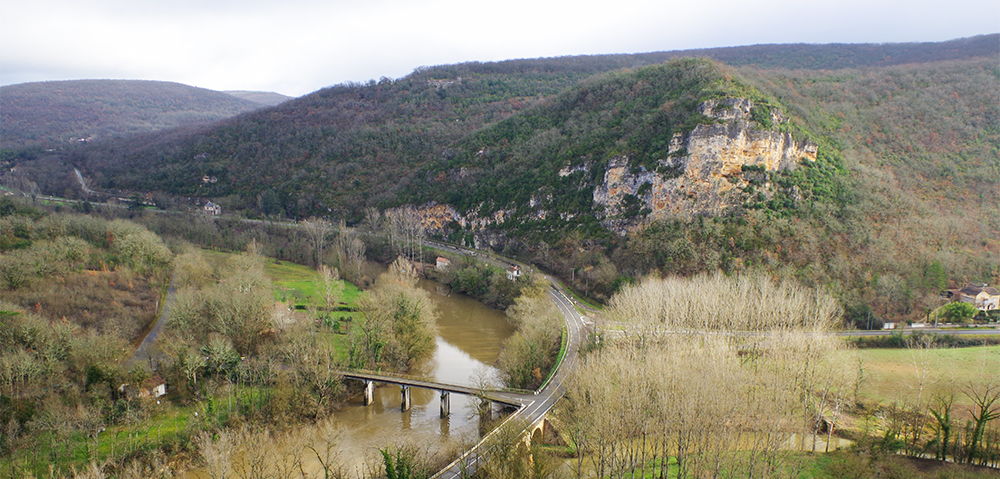
Grotte de Bruniquel, situated in the limestone knoll at the middle right of this image
Photo: © Michel SOULIER – SSAC
Source: http://www.rtl.fr/

Grotte de Bruniquel, interior, showing annular constructions made of broken stalagmites by early Neanderthals.
They date from 176 500 BP, and were found 336 metres from the entrance of the cave.
Photo: © Michel SOULIER – SSAC / Nature Jaubert et al. Source: Jaubert et al. (2016)
The regular geometry of the stalagmite circles, the arrangement of broken stalagmites and several traces of fire demonstrate the anthropogenic origin of these constructions.
Uranium-series dating of stalagmite regrowths on the structures and on burnt bone, combined with the dating of stalagmite tips in the structures, give a reliable and replicated age of 176 500 BP (± 2 100 years), making these edifices among the oldest known well-dated constructions made by humans.
Their presence at 336 metres from the entrance of the cave indicates that humans from this period had already mastered the underground environment, which can be considered a major step in human development.
This discovery indicates that humans began occupying caves much earlier than previously thought. Until now the oldest formally proven cave use dated back only 38 000 years (Chauvet). It also ranks the Bruniquel structures among the very first in human history.
In addition, traces of fire show that the early Neanderthals, well before Homo sapiens, knew how to use fire as a source of light to navigate in safety, and to build structures, in enclosed spaces far from daylight.
Text above adapted from: Jaubert et al. (2016) and the summary of the paper at https://www.sciencedaily.com/releases/2016/06/160601083926.htm
Interior of Bruniquel Cave.
In 1990, the discovery of two circular structures composed of 399 pieces broken from stalagmites on the floor of this cave provoked a veritable earthquake amongst scientists. Situated in a room 336 metres from the entrance, they show that almost 130 000 years before modern humans, Neanderthals had ventured underground. Only traces of several hearths were found, without tools or skeletal remains. The function - practical? symbolic? - of these structures remains unknown to this day.
(left): Salle de la grotte de Bruniquel, low walls, © Yann van den Berghe/SSAC
(right): Salle de la grotte de Bruniquel, hearth, © Michel Soulier/SSAC
Photo: Don Hitchcock 2018
Source and text: Musée de l'Homme, Paris
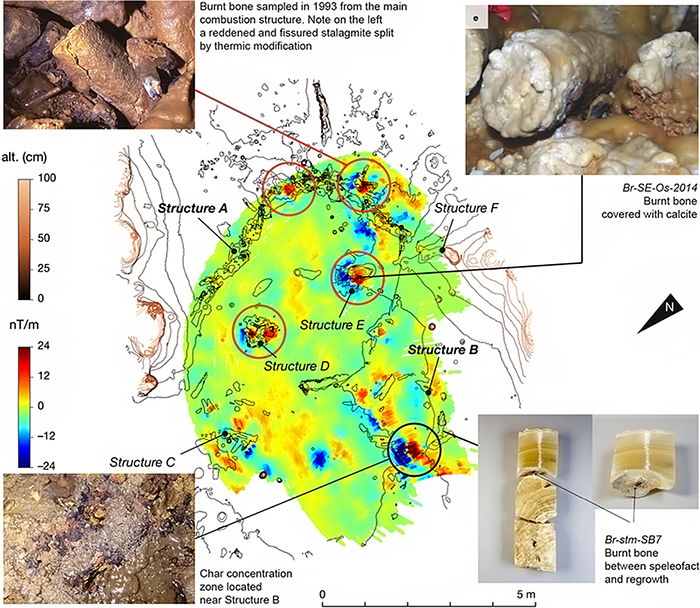
Plan and photos of Neanderthal structures found in Bruniquel Cave.
Photo: Jaubert et al. (2016)

Taking cores for dating from the floor inside one of the structures.
Photo: © Michel SOULIER – SSAC
Source: http://www.rtl.fr/
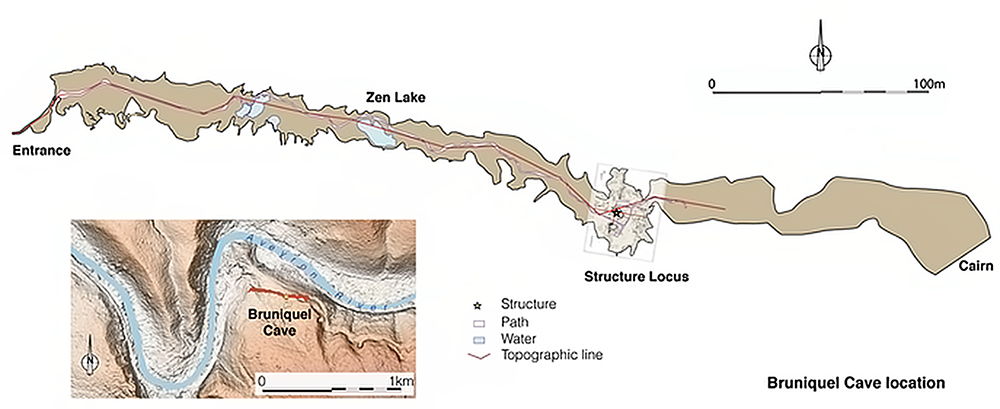
Grotte de Bruniquel, location and cross section, showing the location of the man-made structures.
Photo: Jaubert et al. (2016)
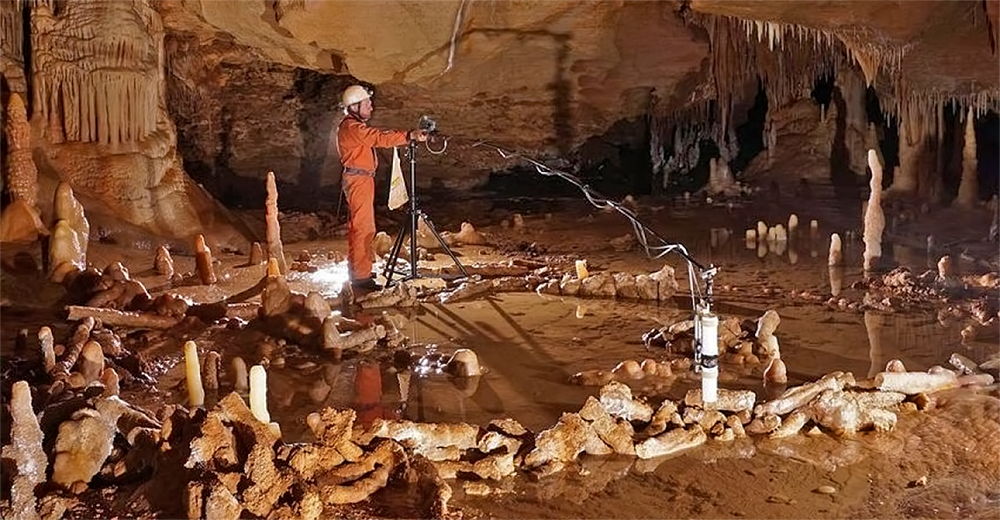
This photo gives a good idea of the scale of the structures.
Photo: Jaubert et al. (2016)
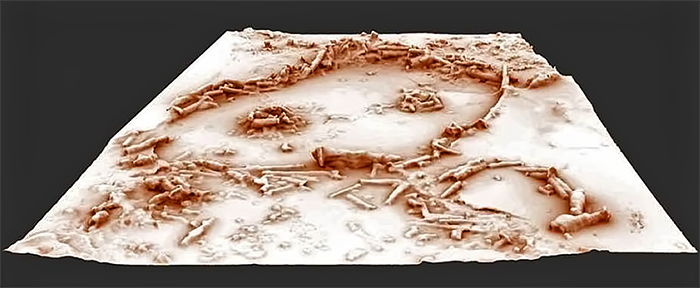
A 3D reconstruction of the Early Neanderthal structures found in Bruniquel Cave by Jaubert's team.
They worked by torchlight, following the same procedure hour after hour: wrench a stalagmite off the cave floor, remove the tip and base, and carefully lay it with the others.
Today we can only guess as to why a group of Neanderthals built a series of large stalagmite structures in a French cave – but the fact they did provides a rare glimpse into our extinct cousin’s potential for social organisation in a challenging environment.
A reassessment of evidence from Bruniquel cave, near Toulouse in south-west France, suggests even more Neanderthal sophistication. In one chamber, 336 metres from the cave entrance, are enigmatic structures – including a ring 7 metres across – built from stalagmites snapped from the cave floor. Natural limestone growths have begun to cover parts of the structure, so by dating these growths a team led by Jacques Jaubert at the University of Bordeaux could work out an approximate age for the stalagmite constructions.
The stalagmite structures are 50 centimetres high in places, says Jaubert. They are built from around 400 individual stalagmites with a combined weight of about 2 tonnes.
'That must take time [to shift],' Jaubert says – although exactly how long it took the Neanderthals to build the structures isn't clear. 'As often in prehistory, measuring time is not easy.' What we do know is that the structures were built in dark, challenging conditions and the builders had no natural light to help them. Indeed, Jaubert’s team found traces of fire at several points around and on the structures.
The simplest explanation is that the structures served as some sort of shelter or refuge – perhaps the stalagmite 'walls' supported a roof of perishable wood, for example – but there are no other artefacts and very few signs of domestic activity in the chamber beyond the presence of one charred bone fragment that possibly belonged to a bear or large herbivore.
That draws comparisons with much later cave sites such as Chauvet, a 30 000 year old site of modern human occupation that is rich in cave art but contained a mere handful of artefacts. So perhaps Bruniquel – like Chauvet – served some ritual role. If so it would provide more evidence for the Neanderthal’s capacity for symbolic thought.
Photo: Xavier Muth - Get in Situ, Archéotransfert, Archéovision -SHS-3D, base photographique Pascal Mora
Source and text: Colin Barras, https://www.newscientist.com/article/2090183-neanderthals-built-mystery-underground-circles-175000-years-ago/
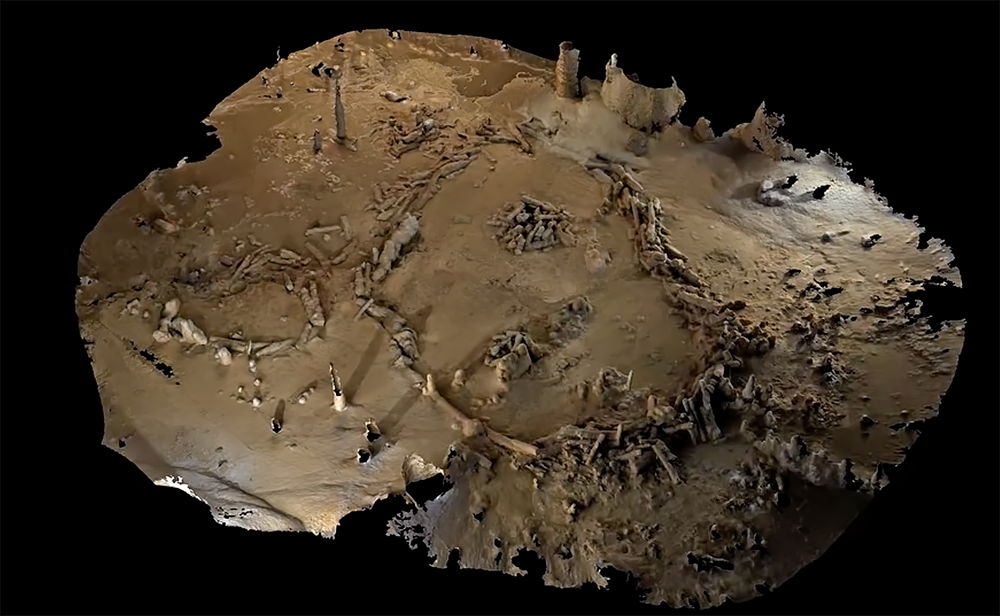
Grotte de Bruniquel 3D model from photogrammetric acquisition by Archéotransfert as part of the study of anthropic structures in Bruniquel Cave.
Photo and text: vimeo.com/168174627
Neanderthal mask from La Roche-Cotard, Langeais, France
Circa 75 600 BP.
Photo: Don Hitchcock 2018
Original, Private Collection
Excavations of Jean-Claude Marquet
Source and text: Musée de l'Homme, Paris
This interesting article below comes from the BBC, at http://news.bbc.co.uk/1/hi/sci/tech/3256228.stm
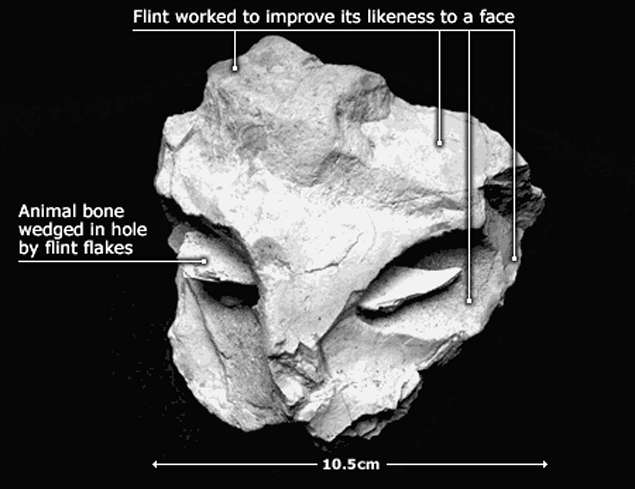
A flint object with a striking likeness to a human face may be one of the best examples of art by Neanderthal man ever found, the journal Antiquity reports.
The "mask", was recovered on the banks of the Loire in France.
It is about 10 cm tall and wide and has a bone splinter rammed through a hole, making the rock look as if it has eyes.
Commentators say the object shows the Neanderthals were more sophisticated than their caveman image suggests.
"It should finally nail the lie that Neanderthals had no art," Paul Bahn, the British rock art expert, told BBC News Online. "It is an enormously important object."
It is described in Antiquity by Jean-Claude Marquet, curator of the Museum of Prehistory of Grand-Pressigny, and Michel Lorblanchet, a director of research in the French National Centre of Scientific Research, Roc des Monges, at Saint-Sozy.
The mask was found during an excavation of old river sediments in front of a Palaeolithic cave encampment at La Roche-Cotard.
Tool and bone discoveries suggest Neanderthals used the location to light a fire and prepare food.
Triangular in shape, the object shows clear evidence, the researchers say, of having been worked - flakes have been chipped off the block to make it more face-like.
The 7.5-cm-long bone has also been wedged in position purposely by flint fragments.
Marquet and Lorblanchet write in Antiquity: "We think that this is indeed a 'proto-figurine'; that is, a small flint block whose natural shape evokes a crudely triangular human face - or a mask if one notes that it is primarily the upper part of the face that is concerned, like a carnival mask, or, rather less clearly, an animal face, perhaps a feline?
"It was not only picked up and brought into the habitation, but was also modified in various ways to perfect its resemblance to a face: the forehead, the eyes underlined by the bone splinter, the nose stopped at its extremity by an intentional flake-removal, and the rectified cheeks."
They are convinced this object is no accident of geology. Jean-Claude Marquet told BBC News Online: "The sliver of bone was pushed in forcibly and wedged with two pebbles.
"Chance could not have inserted the stones in between the bone and the block in such a balanced way, with the two ends coming out equally either side."
Bahn believes the Roche-Cotard mask should set the record straight on Neanderthals' artistic capabilities.
"There are now a great many Neanderthal art objects. They have been found for decades and always they are dismissed as the exception that proves the rule.
"This is not just a fortuitous bone shoved into a hole in a rock. Whether the Neanderthal artist saw a rock that looked like a face and modified it, or conceived the thing from the start - who knows? Either way it is pretty sophisticated."
And Marquet added: "This object shows that art was not born in the brain of Homo sapiens but much earlier in the brains of predecessors like the Neanderthal man and even, no doubt, in Homo erectus.
"Neanderthal man was not a coarse character incapable of elaborate mental thought. Here, he has used a rock with a particular natural form to make a face emerge from its shape."
One of the oldest examples of modern human art generally accepted by the scientific community would be the 77 000-year-old engraved ochre pieces found in the Blombos Cave in South Africa.
However, earlier this year, scientists announced the discovery of the oldest Homo sapiens skulls. These 160 000-year-old fossil bones had been polished after death.
This mortuary practice suggests at least these early people were abstract thinkers, capable of analysing ideas of life and death.
Text and photo adapted from: http://news.bbc.co.uk/1/hi/sci/tech/3256228.stm
It can be speculated that the first true art may well have been decoration of the human body with clay and ochre, but of course there is no record of that, apart sometimes of ochre found on the skeletons of the dead, but we do have some records of isolated musical instruments such as flutes, whistles, or scraper idiophones, instruments that are scraped with a stick or other foreign object to give off a sound, or bullroarers, flat pieces of wood or bone whirled around the body on a string to create a howling or whirring sound, which can carry for considerable distances) of the first performing arts of dance and song.
The earliest musical instruments

Neanderthal Flute
The Divje Babe Flute is a cave bear femur pierced by spaced holes that was found in 1995 at the Divje Babe archeological park located near Cerkno in northwestern Slovenia. It has been suggested that it was made by Neanderthals as a form of musical instrument, its hole spacing and alignment leading to its being labeled a 'Neanderthal flute'. A form of flute, it is possibly the world's oldest known musical instrument. According to Electron spin resonance (ESR) dating of the layer containing the flute it is between 50 000 to 60 000 years old.The artefact remains on prominent public display in the National Museum of Slovenia in Ljubljana as a Neanderthal flute.
In 1995, Ivan Turk found the cave bear femur at the Divje Babe site near a Mousterian hearth. Because it has the characteristics of a flute he has dubbed it a Neanderthal flute. It is broken at both ends, and has two complete holes and what may be the incomplete remains of one hole on each end, meaning that the bone may have had four or more holes before being damaged. The bone fragment is the diaphysis of the left femur of a one to two year old cave bear and is 133.6 mm (5.26 in) long. The maximum diameter of the two complete holes is 9.7 mm (0.38 in) and 9.0 mm (0.35 in). The distance between the centres of the holes is 35 mm (1.38 in).
( My sincere thanks to Dr Matija Turk, PhD, Institute of Archaeology - ZRC SAZU for his kindness in sending me his very relevant paper, and for his comments and help in making this report more accurate - Don )
Photo: Ralph Frenken, 2018
Source: Original, National Museum of Slovenia in Ljubljana
Text: Turk et al. (2018)
Additional text: Wikipedia
However we are mostly restricted in the artistic archaeological record to marks, engravings, and paintings on walls and rocks, as well as carved objects, often of wood or ivory or bone, and hung from the neck or placed in a niche in an abri or other rock shelter.
References
- Soressi, M., d'Errico, F., 2007: Pigments, gravures, parures: les comportements symboliques controversés de Néandertaliens www.researchgate.net
- Turk M. et al., 2007: Sediments at the Divje babe I site, in: Turk, I. (Ed.) Divje babe I: Upper Pleistocene Palaeolithic Site in Slovenia, Part 1: Geology and PalaeontologyL'Anthropologie, Volume 122, Issue 4, September–October 2018, Pages 679-706
- Turk M., Turk I., Dimkaroski L., Blackwell B., Horusitzky F., Otte M., Batiani G., Korat L., 2018: The Mousterian Musical Instrument from the Divje babe I cave (Slovenia): Arguments on the Material Evidence for Neanderthal Musical Behaviour, Opera Instituti Archaeologici Sloveniae, 13, ZRC Publishing, Ljubljana, pp. 105–121.
Back to Don's Maps
 Back to Archaeological Sites
Back to Archaeological Sites
